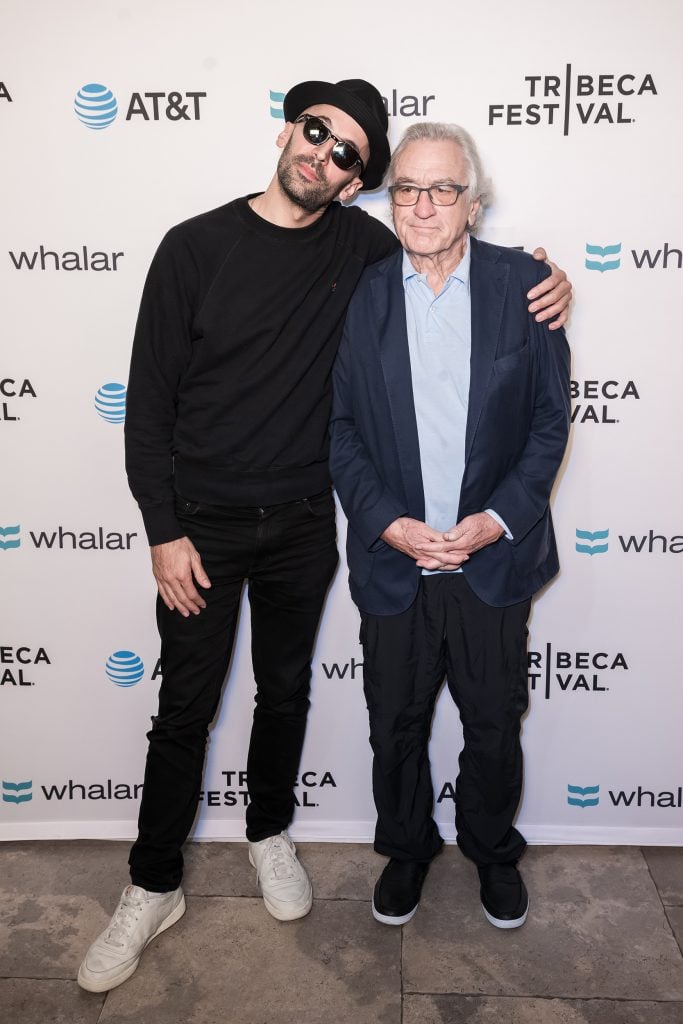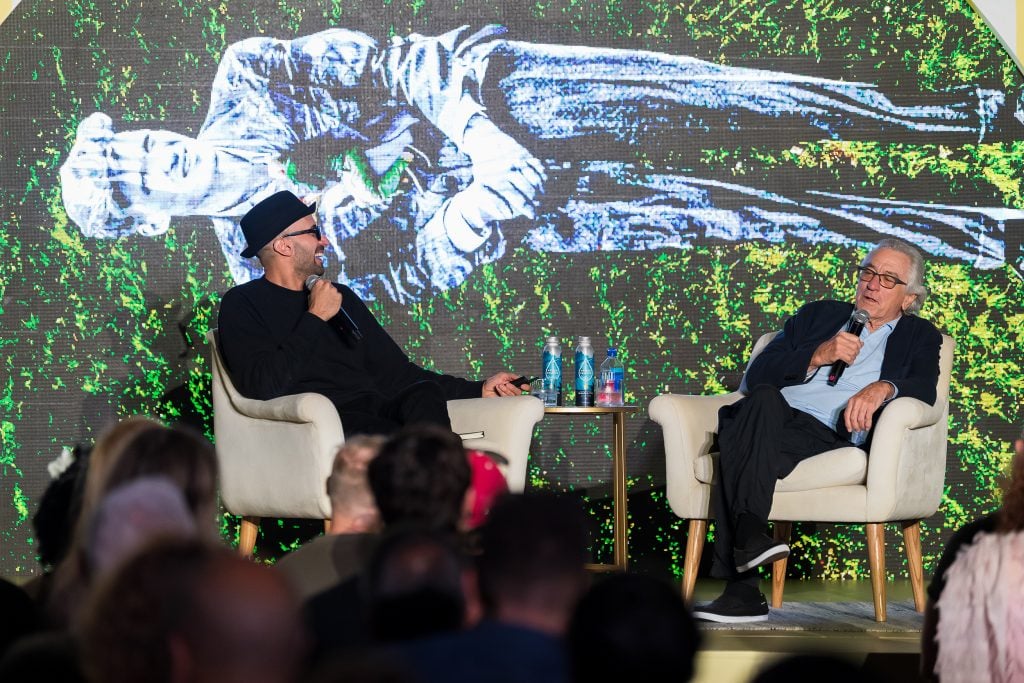Pop Culture
JR and Robert De Niro Are Making a Documentary on the Art and Life of the Actor’s Late Father
The duo discussed the film, "The Past Goes Fast," in a conversation at Art Basel Miami Beach.

The duo discussed the film, "The Past Goes Fast," in a conversation at Art Basel Miami Beach.

Hollie McLaughlin-Martin

Last week, the Tribeca Festival headed south to make its Art Basel debut. The renowned film festival, co-founded by Robert De Niro, partnered with Art Basel to bring exclusive conversations with iconic artists to Miami Beach. De Niro and photographer JR were in conversation on December 9 to discuss their upcoming documentary, The Past Goes Fast, which traces the artistic career of De Niro’s father through his work and private diaries.
De Niro and JR are an unlikely duo. JR, the French photographer and street artist known for his large scale murals, is shrouded in mystery. The artist’s full name is unknown, and he is never seen in public without his signature black hat and sunglasses to shield his identity. De Niro, on the other hand, is a public figure whose story, both professional and personal, is well known. The legendary actor, producer, and director has been involved in the film industry since the 1960s. He is the son of Robert De Niro Sr., a painter, and Virginia Admiral, a painter and poet—a family history that the duo’s new project explores.
Unlike their 2015 project, Ellis, which documented the early years of Ellis Island through the experience of one immigrant, this latest documentary is ever-evolving. “We just started this project two years ago and it can go on for years and years.” JR said at the event.

JR and Robert De Niro speaking onstage at the Tribeca Storytellers event at Art Basel Miami Beach on December 9, 2023. Photo: Jason Koerner/Getty Images.
A film clip played during the conversation unfurls at the heart of De Niro Sr.’s world, his art studio which has been untouched since death nearly 30 years ago. The walls of the studio are lined with his artworks and its tables piled with the artist’s personal journals. “I haven’t read them,” De Niro says to JR in the clip, gesturing towards the journals. The actor instead encourages JR to flip through its pages and read them aloud.
“I’ve been through those journals. There’s so much in there. It’s so deep; it’s like reading something from an artist that was struggling a lot with self-esteem and being recognized,” JR shared at the event. “I sense a lot of loneliness in him. And to be honest, we can read it through the journals.” As a child, De Niro didn’t know his father was gay and embarked on a lonely internal struggle with his identity. In his words, the journals have allowed him to see other dimensions of a father he described as “preoccupied with himself” and not as social as other artists were.
To break down De Niro’s walls so he could emotionally connect with his family history, JR involved him in a series of symbolic performance sequences. For example, in the film, De Niro is asked to carry a large blown-up print depicting his father in JR’s signature style. The actor then lays the work out in a field, before lying on top of it at JR’s instruction.
“That was a very moving day,” JR explained to the audience. “I kept telling you, you got to look into your father’s eyes, at least from the camera point of view. It was hard for you to do so. And that day we had your very close friends, like Martin Scorsese, who were also there in that scene. I feel your friends and the people you have worked with over the years, they will help you in this journey. And that’s something incredible.”

JR and Robert De Niro speaking onstage at the Tribeca Storytellers event at Art Basel Miami Beach on December 9, 2023. Photo: Jason Koerner/Getty Images.
For his part, De Niro highlighted how artifacts of his father’s life that have enabled him to share his legacy with future generations. De Niro Sr.’s studio, he said, was “left it exactly the way it was because I just didn’t want to touch it. In the back of my head, I was thinking of my kids who haven’t seen much of it. I wanted them to know what a great artist he was to me and a genuine artist.”
Photos of De Niro Sr. have also been a way for the actor to reach back into his memories. “I wish I did have more photos though when I was younger. I had a friend who would always have a camera with him and take pictures to the point of annoyance. Now, I have these photos and I’m so glad he took them,” he said.
“There’s nothing comfortable about looking back, looking at our families, looking at the story of our parents, about things we shouldn’t know about,” JR added, before addressing De Niro: “I have done projects with groups and with communities in places. But you made me do something that I had never done before… to go and see it within ourselves.”
More Trending Stories:
Art Dealers Christina and Emmanuel Di Donna on Their Special Holiday Rituals
Stefanie Heinze Paints Richly Ambiguous Worlds. Collectors Are Obsessed
Inspector Schachter Uncovers Allegations Regarding the Latest Art World Scandal—And It’s a Doozy
Archaeologists Call Foul on the Purported Discovery of a 27,000-Year-Old Pyramid
The Sprawling Legal Dispute Between Yves Bouvier and Dmitry Rybolovlev Is Finally Over